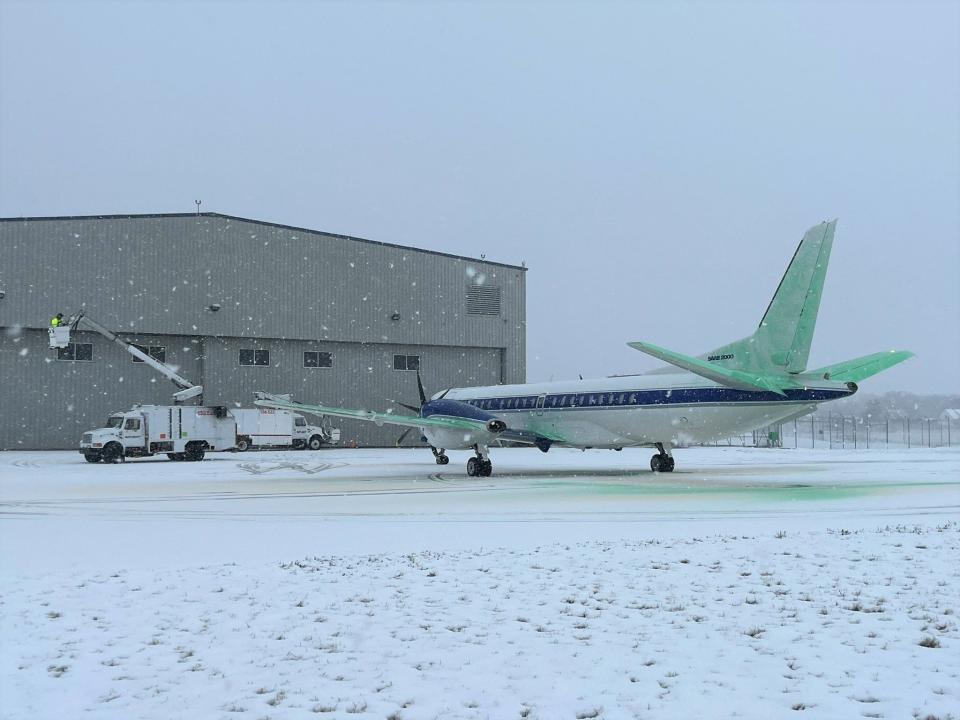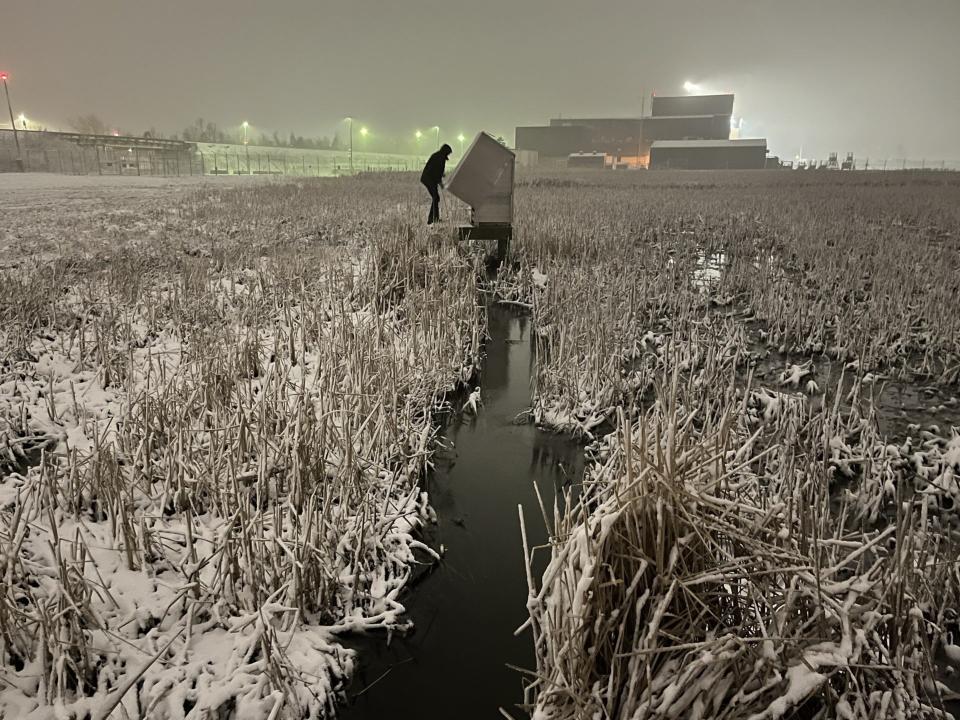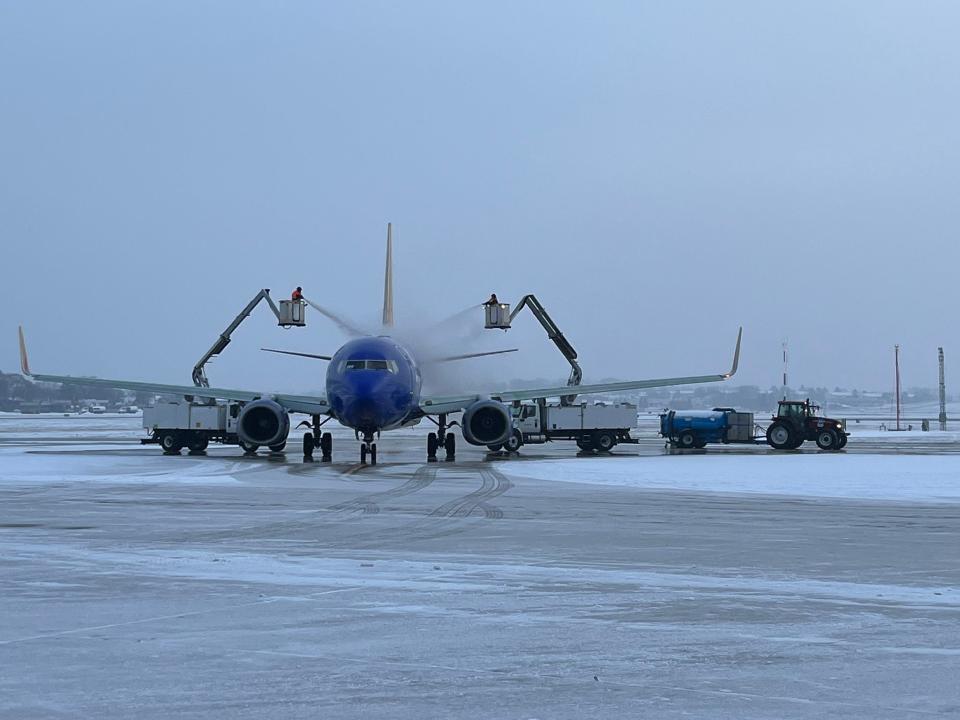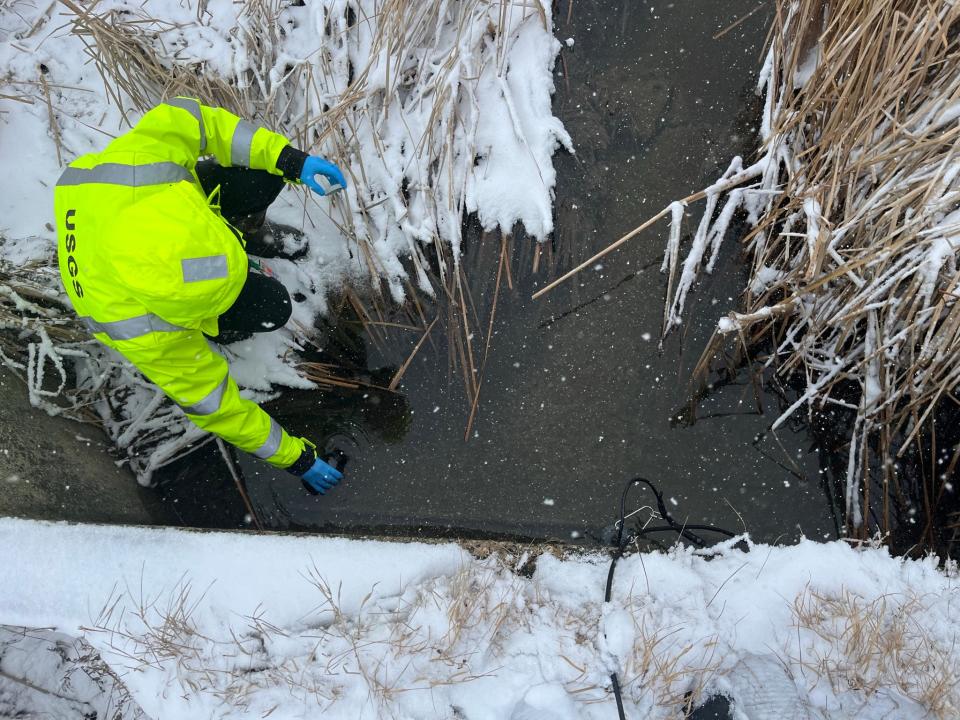Deicing products used at Milwaukee Mitchell Airport may be harming Lake Michigan and local waterways, study finds
Dealing with freezing weather conditions is an inevitable part of living in the Midwest. And while removing snow and ice from airplanes and runways is essential for safe air travel, a recent study suggests popular deicing products may be harming Lake Michigan and its tributaries.
According to the study by the U.S. Geological Survey, waterways downstream of Milwaukee Mitchell International Airport had phosphorus levels that exceeded state benchmarks for healthy aquatic ecosystems during freezing weather. The scientists traced these phosphorus levels to common ice control products used at airports.
Here's what you should know.
Deicers remove ice and snow from aircraft, runways
The Federal Aviation Administration requires that airports use ice control products on aircraft and runways during freezing weather. Even a small amount of ice and snow can change how air flows over the wings and other parts of the plane, changing how the plane flies and creating a safety hazard. Runways also need to be cleared of snow and ice so planes can gain traction when they land at high speeds.
Aircraft deicing fluid, also known as Type I fluid, is a mixture of propylene glycol and water that lowers the temperature that water freezes at, helping to remove snow and ice. Airports in colder climates also use anti-icers, or Type IV fluid, which stops water from freezing after the deicer is applied and before the plane takes off.
Phosphorus is likely present in these products because it can help prevent corrosion, said Owen Stefaniak, a physical scientist with the U.S. Geological Survey and author on the study.
Airports are required to have a stormwater discharge permit, which includes a pollution prevention plan, and stormwater runoff is regulated by state agencies with guidance from the U.S. Environmental Protection Agency.

Waterways exceeded phosphorus standards during ice, snow storms
The scientists first looked at 11 popular deicing products and found that nine had significant amounts of phosphorus. Then, they collected water samples for five years in nearby waterways during and immediately after winter storms when airport personnel were deicing planes.
The team found that 84% of water samples collected had phosphorus that could be traced back to ice control products. And 70% of samples had phosphorus levels that exceeded phosphorus standards from the Wisconsin Department of Natural Resources.
The amount of phosphorus that is coming from these products is concerning, Stefaniak said, and there is a potential the amounts could be harming aquatic ecosystems.

More: Road salt is washing into Wisconsin's major waterways, with alarming results
Creeks, streams sampled flow into Lake Michigan
Most of the runoff from the airport is bound for Lake Michigan, Stefaniak said.
A lot of this winds up in Wilson Park Creek, he said, which flows northwest through the airport before it joins the Kinnickinnic River. The lower reach of the Kinnickinnic River is part of the Milwaukee River Estuary, which is listed as an area of concern, or one of the most degraded areas in the Great Lakes.
There is another unnamed stream in the southern corner of the airport that drains into Oak Creek, also bound for the lake.
More: Milwaukee is turning around one of the most degraded sites in the Great Lakes. Here's how.

Too much phosphorus can cause algae blooms, explosive plant growth
Agriculture is usually the first thing that comes to mind when people think of phosphorus pollution, Stefaniak said, but it is a big issue in a lot of different settings.
Phosphorus is a limiting nutrient in many freshwater systems, meaning that there is less of it compared to other nutrients and it limits the growth of organisms. When more phosphorus does become available it can cause explosive growth of plants and algae, which can in turn deplete oxygen levels and cause loss of fish and aquatic habitats.
The nutrient is also the main driver of blue-green algae blooms that can sometimes produce toxins harmful to humans and pets.

And while the Wisconsin DNR issued new standards for phosphorus in 2010, it is still not measuring up to the magnitude of the problem. This is especially true in the Lower Fox River and bay of Green Bay, where harmful algae blooms and a dead zone plague the waters.
The study was a first step to figure out how much phosphorus is winding up in waterways, Stefaniak said, and it's unclear how the nutrient is affecting local aquatic ecosystems. The next step, he said, is to figure out what happens once the phosphorus is in the water.
More: Pesticides, normally found in Great Lakes tributaries during summer, now found year-round
Deicing fluid can be collected and recycled
While the samples were collected in Milwaukee, Stefaniak said this is likely a global problem. In the U.S. alone, there are more than 200 airports that use these products, which are only made by a few manufacturers, he said.
"This is one of those wicked problems where we have to balance human safety and protecting the environment," Stefaniak said. "We all want to feel safe every time we get on an airplane."
Previous work by scientists at Western Washington University and the U.S. Geological Survey found that an additive commonly found in deicers and anti-icers, called benzotriazole, was toxic to fish. Since then, manufacturers have removed this chemical.
Airports do take measures to reduce runoff from these products. And some even recycle the deicing fluid so the glycol in the products can be used again, like at Pittsburgh International Airport, Salt Lake City International Airport and Syracuse Hancock International Airport.
According to Harold Mester, the director of public affairs at Milwaukee Mitchell International Airport, Milwaukee's airport works with the U.S. Geological Survey year-round to monitor water quality and there is a program to collect the deicing products to minimize runoff. That fluid is used by the Milwaukee Metropolitan Sewerage District to generate electricity using its anaerobic digesters at the South Shore Water Reclamation Facility, Mester said.
Caitlin Looby is a Report for America corps member who writes about the environment and the Great Lakes. Reach her at clooby@gannett.com or follow her on X @caitlooby.
Please consider supporting journalism that informs our democracy with a tax-deductible gift to this reporting effort at jsonline.com/RFA or by check made out to The GroundTruth Project with subject line Report for America Milwaukee Journal Sentinel Campaign. Address: The GroundTruth Project, Lockbox Services, 9450 SW Gemini Dr, PMB 46837, Beaverton, Oregon 97008-7105.
This article originally appeared on Milwaukee Journal Sentinel: Deicers may be polluting waters near Milwaukee Mitchell Airport: Study

